AMD ThreadRipper 2: First Meet
- Transfer
The loudest news that sounded at the world's largest international computer exhibition: the second generation AMD Ryzen Threadripper is here. In today's announcement, there are a lot of images, descriptions of speeds and channels, specifications and unboxing announcements, in a word, a direct hint at opening pre-orders a week before retail sales (at the time of writing the original article). With a heavy burden on my heart, I hasten to notify the reader that due to the unboxing embargo, we simply do not have the right to publicize how the new chips will work. We will review the specifications, discuss the design and demonstrate the materials that AMD has provided in its press kit.
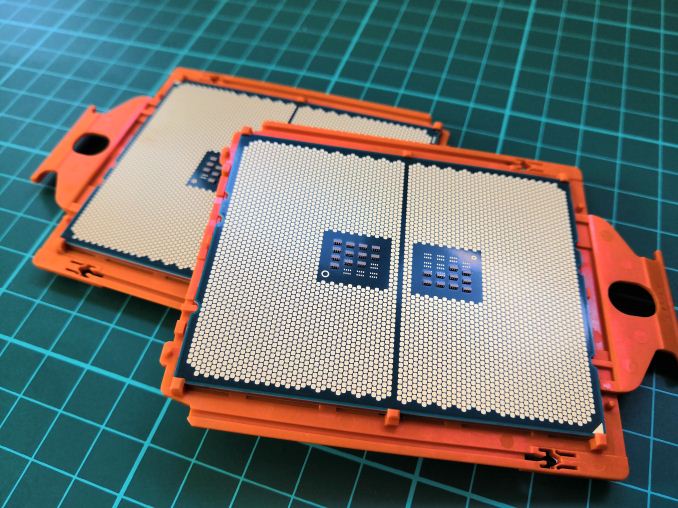
2990WX for pre-orders was opened on August 6, 2018. The start of retail sales began on August 13th.
Officially, the sale of new processors began on August 13, but in the largest markets, the first processors were available for pre-order already on August 6. AMD plans to launch four second-generation versions of the Ryzen Threadripper during the third quarter, starting with the flagship 32-core CPU.
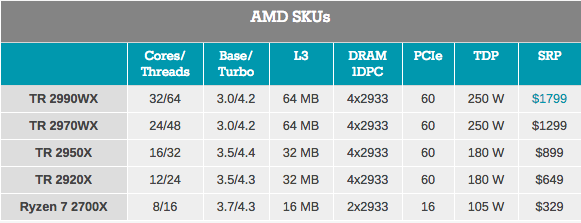
At the top of the list of new processors is the 32-core 2990WX, with a recommended price of $ 1,800, which makes it a direct competitor to the already existing 18-core Intel Core i9-7980XE. AMD uses "WX" in the title to somehow show the consistency of branding with its high-quality Radeon Pro WX series graphics processors.
The heart of the most powerful ThreadRipper is the four Zen + Zeppelin 12 nm arrays, each with eight cores connected by Infinity Fabric from AMD, which provides simultaneous multithreading for all 64 threads. As in previous generations, there are 60 PCIe 3.0 lanes for drives or other devices, and four more lanes for the chipset. The speed of working with memory has been increased - the new processors support DDR4-2933.
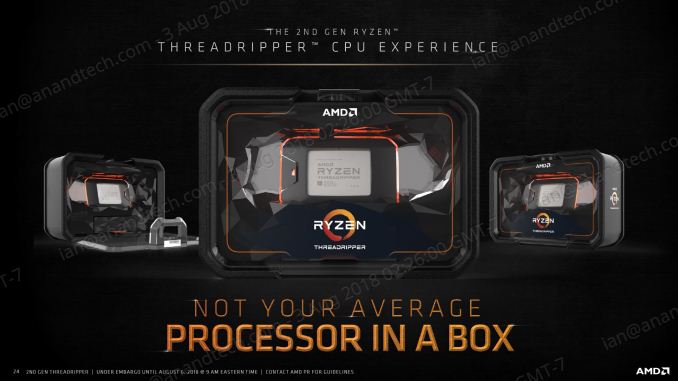
The WX continues with the Ryzen Threadripper 2970WX line, which is noticeably cheaper: $ 1299 MSRP. This 24-core CPU uses three cores on the CCX (six cores per matrix, and the processor includes four such matrices), has simultaneous multithreading for all 48 threads. The core frequencies are the same as the TR 2990WX, the base 3.0 GHz and the single-core 4.2 GHz turbo. As shown below, the turbo speeds on the primary level will be determined by Precision Boost 2 and XFR2. The launch of 2970WX is scheduled for October.
Both WX models have a very high TDP of 250 W, although the way AMD measures TDP largely depends on the cooler used. The “benchmark” version is the new high-end Wraith Ripper cooler, which was developed by the Cooler Master. The cooler is very large, it offers full radiator coverage, which, as we found out, is crucial for cooling the Threadripper. The cooler will be sold separately, the fixed price is about $ 100 MSRP.

The next in the table are 2950X ($ 899) and 2920X ($ 649), which use the already existing X branding. Processors are direct replacements for the 1950X and 1920X. Each chip has only two active matrices, but plus it uses Zen + technology, Ryzen’s second-generation features, such as faster caches and better frequency response. The 16-core TR 2950X will have a base frequency of 3.5 GHz, a 4.4 GHz turbo and should go on sale on August 31. The 12-core TR 2920X, for comparison, comes with a base frequency of 3.5 GHz, but a 4.3 GHz turbo, and will be released in October. Both processors have 180 W of TDP, as well as chips of the first generation.

So far, AMD has not announced plans to expand the family, so we do not know whether 1900X will remain at the bottom of the stack, whether it will be replaced by a 2000 series model, or simply out of production.
At this stage, AMD is still opposing Intel’s Skylake-X components. The 32-core 2990 WX will align with the 18-core Core i9-7980XE.
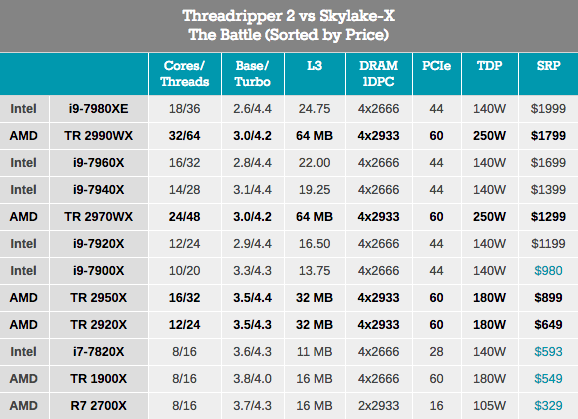
As for the specifications, AMD has a large number of cores, is competitive in frequency, has more memory channels, more PCIe-bands and supports higher memory clock speeds. Intel, in turn, has lower power and a slight advantage in turbo frequencies. Meanwhile, we have already figured out from the Ryzen 2000 test series that there is a serious opposition in caching speed, and Intel has a slight advantage in IPC. The game has begun.
The entire Ryzen Threadripper 2000 series has Zen cores in the “Zen +” mode, which adds three or four new features that are identical to the Ryzen 2000 series.
First, these are faster caches of all levels. As we saw in our review of the Ryzen 7 2700X, the L1 and L2 caches are slightly faster, the L3 cache was somewhat faster. Memory frequency support increased from DDR4-2666 to DDR4-2933. All this explains the increase in IPC by 3% and is the result of a better understanding of the design and adjustment of internal interactions for better performance.
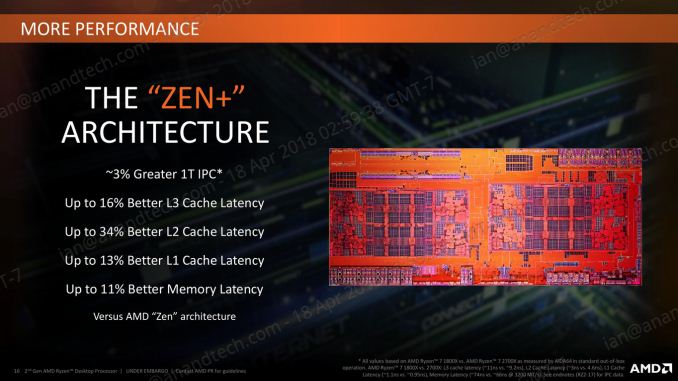
Secondly, Zen + cores were created using the GlobalFoundries 12-nm process, an enhanced version of the 14-nm process that was previously used in the Threadripper-1000. Although optical shrinkage does not allow AMD to use higher frequencies or reduce voltage, along with a new turbo methodology and a 3% increase in IPC from caches, the overall performance increase in Ryzen 2000 series processors was 10%.
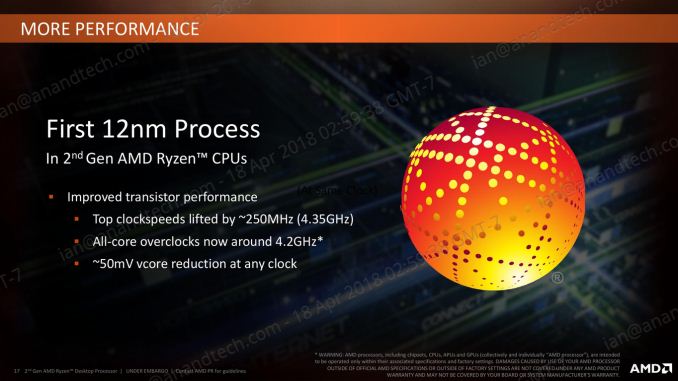
The third function is Precision Boost 2, which controls how the CPU implements its turbo depending on the workload. Instead of referring to a fixed turbo table, depending on how many cores are active and at what frequency, PB2 uses internal sensors and determines what energy / temperature is still available, and offers the CPU to increase the frequency until it reaches barrier. Due to the 25-MHz multiplier pitch, this allows the processor to maximize performance. We have seen the work of this function on the processors of the Ryzen 2000 series, the processors worked very well, although it is worth noting that this results in an increase in energy consumption for workloads with variable multithreading.

Fourth, this is XFR2, or “eXtended Frequency Range”. This is, in fact, the “temperature” bit of Precision Boost 2, taking advantage of the cooler ambient temperature and better cooling to increase the processor frequency. This provided an increase in performance by 10-15% for Ryzen 2000 series processors. In this announcement, not being able to conduct our own performance tests, we cannot provide you with accurate data. For this reason, both the Wraith Ripper (250 W air cooler) and Enermax Liqtech 240 (500 W liquid cooler) were included in our review.
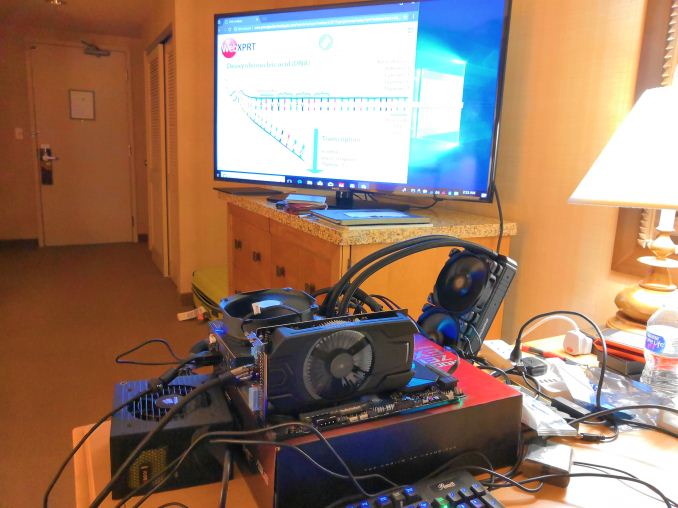
(Note: we are currently experiencing a heat wave in Europe, one of the biggest in the world, and home air conditioning in the UK is out. As a result, AMD faces a potential failure, as many reviewers will be hampered by the super-high level of ambient air in their home space ( 32C +.) I was lucky - Intel invited me to an event in San Francisco this week, so, despite the fact that I had to drag 30 kg of equipment to a distance of 5500 miles, I am currently testing in a hotel room with a regulator at a temperature of 20 ° C. All this is said so that European reviewers will repeat the test after a few months when the ambient temperature returns to a pleasant coolness).
One of the main questions, during the announcement of the second generation of Threadripper, concerned the configuration of the memory. In the first generation, two active crystals on the chip used two memory channels, for a total of four. The second generation with four active matrices now has an uneven memory design: two matrices have access to two memory channels each, while the other two matrices have zero memory channels that are directly connected. It turns out to access the memory requires a transition.
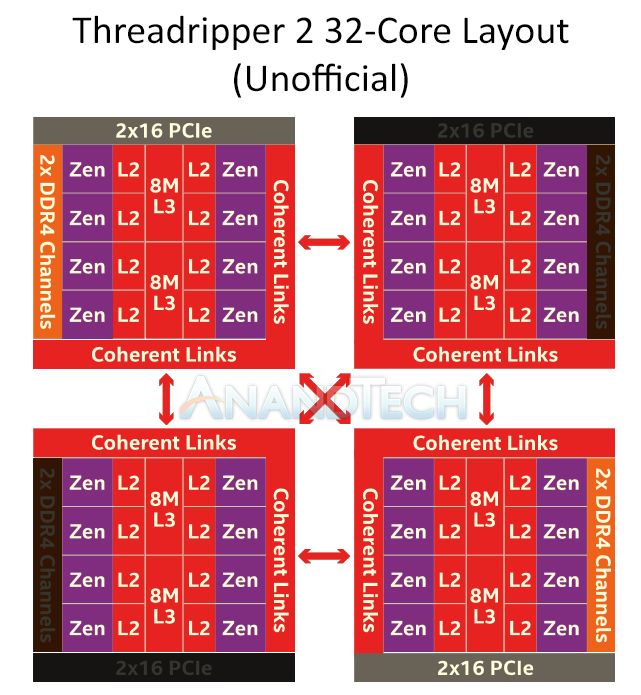
To clarify and avoid speculation, this is NOT a single-channel design per matrix. It is intended only to update the mid-level micro-architecture, and not to complete the update. One advantage is that these processors must fit into all motherboards that are currently on the market, without BIOS firmware. After installing the processor, a BIOS update is recommended for enhanced memory support and additional functions.
When discussing the issue with AMD, we were informed that this memory configuration works as follows: the scheduler in the operating system seeks to first fill in the kernels directly connected to the memory controller. Nevertheless, it is very difficult to initially load all 16 cores on two directly connected matrices: after the first several streams have been allocated, the new streams will enter the cyclic rotation mode, where the “value” of the stream and its core changes depending on how they are loaded. other kernels. If it makes sense in terms of power and temperature parameters, flows will appear on silicon that is not directly connected to memory, for example. Planning threads Threadripper 2 is much more difficult than it might seem at first glance.
Although users have talked many times about better memory allocation, almost no one has touched on the PCIe situation. As in the case of memory, PCIe lanes will also come from only two silicon arrays, and not split between all four. Therefore, most motherboards must support multiple graphics cards and other optional devices.
In general, the new chips are very similar to the old ones:

AMD provided us with 2990WX and 2950X for our review on the release day. Both processors come out in August, first from 2990WX on August 13th, and then from 2950X (on the 31st).
On the reverse side, there is some difference in the arrangement of the components depending on the different active matrices:
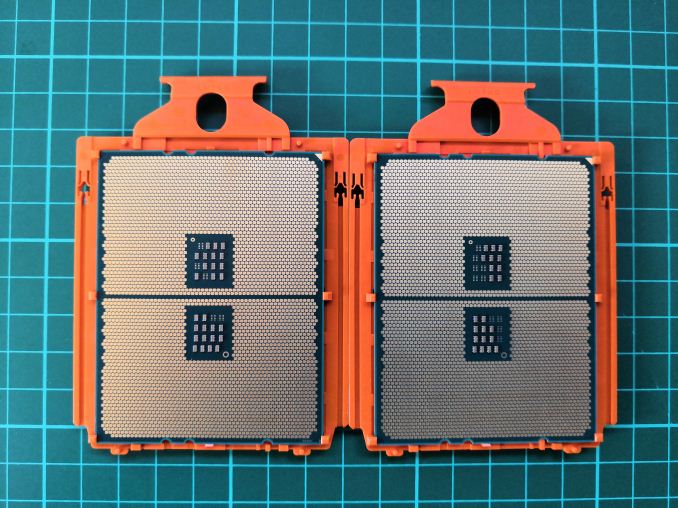
2990WX (left) and 2950X (right) The
packaging has certainly become different - AMD seems to have taken into account public comments on the first-generation packaging. My only feedback for AMD is now this: make a new stackable processor package - because for a reviewer who has a lot of these chips there is no possibility to fold them properly, and this becomes an “organizational” nightmare.

In addition, the box contains a Torx screwdriver for a socket and an Asetek water cooler bracket, as well as for the first generation.
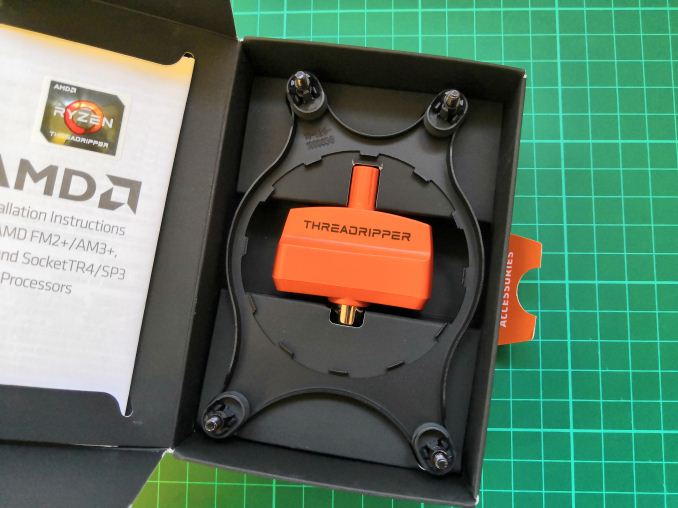
We decided to add EPYC properties to the mix and take a nice photo. Here are the 172 Zen cores:
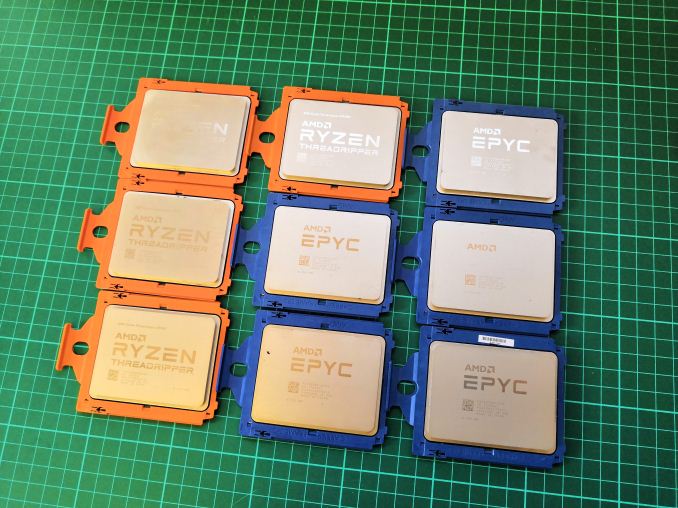
AMD has included two motherboards in the press kit: the second revision of the ASUS X399 Zenith Extreme with the new VRM cooling kit, and MSI X399 MEG Creation, the 19-phase monster shown in Computex.
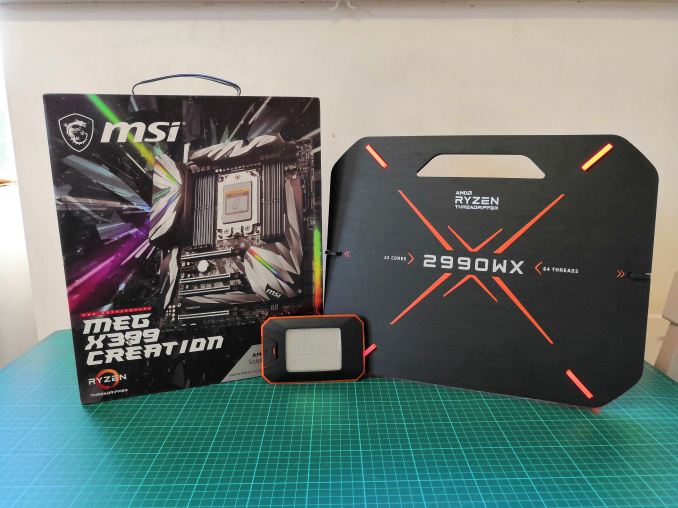
At first, they could not interest Summer:
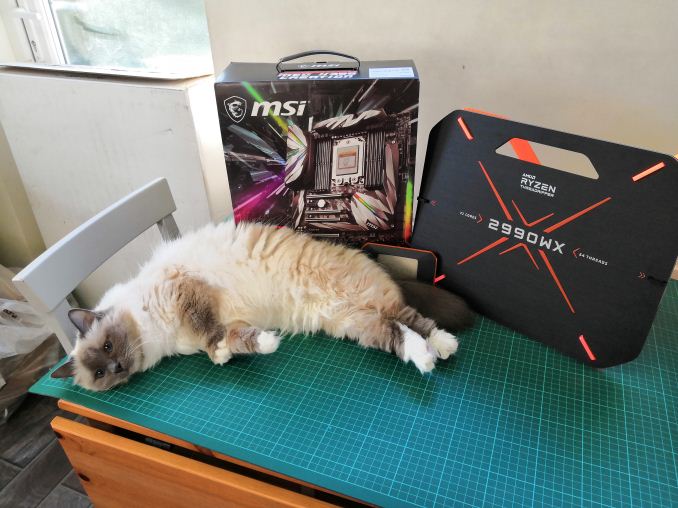
But then she sniffed them:

And they became friends. (ed: Ian, if you kill this processor with static electricity, I will kill you.)

Installation note. Processors do it as they want.
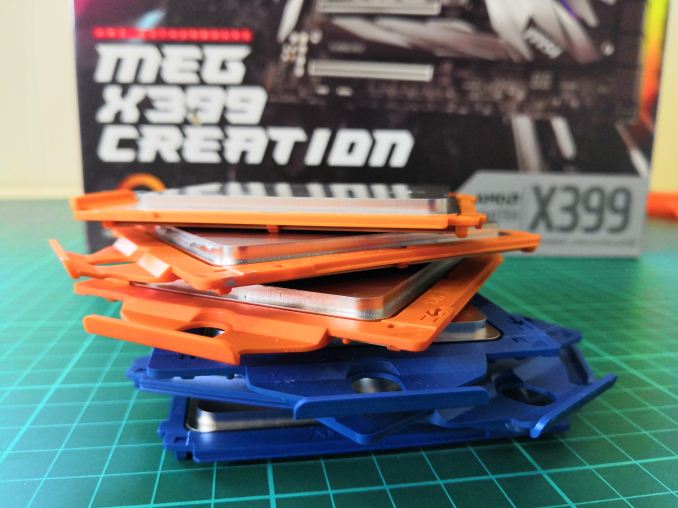
But this is hardly a good idea.
As for the motherboard, AMD explained that all motherboards on the market today will be able to work with the new 250 W processors. The differences in how well each motherboard can accelerate. AMD believes that new models and versions should work better, given that they were built with a higher power rating. Boards like the X399 Creation should help advance the first-generation Ryzen Threadripper.
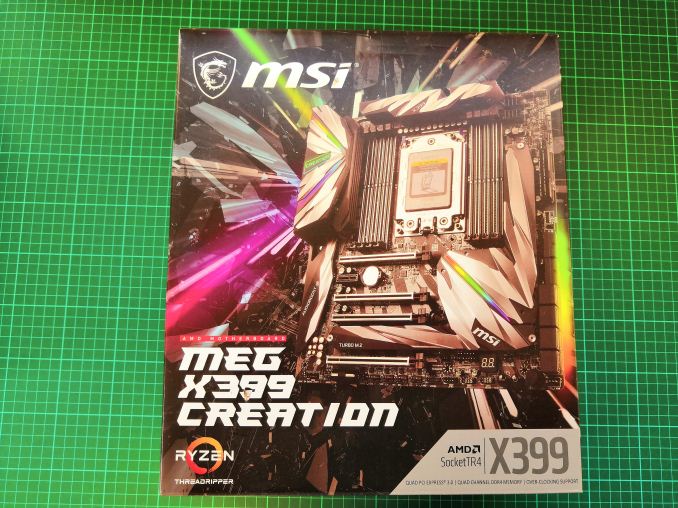
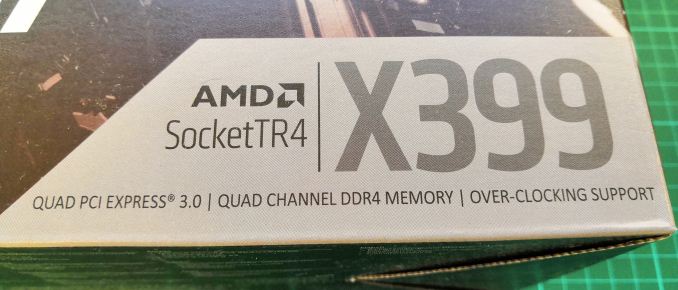
This is a box. And inside the board.
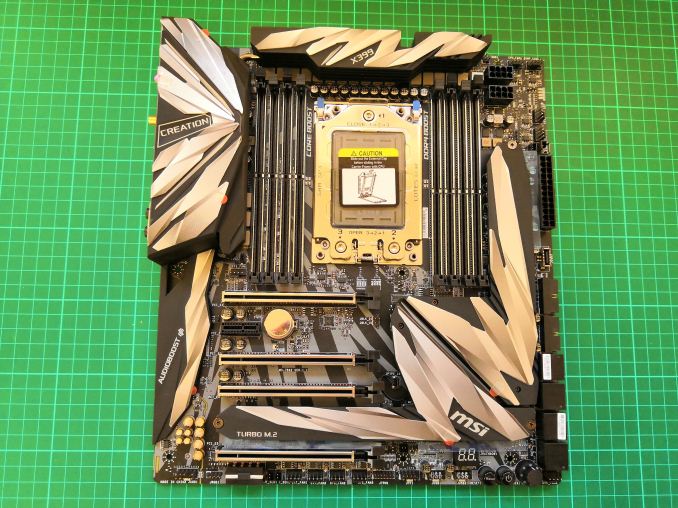
As noted on the Computex, MSI X399 Creation is a very visually filled motherboard. Many corners and many shades of gray. I know that in some Asian languages and magazines it is customary to place everything as closely as possible, so I perceive it. As for me, I prefer a more simple, elegant design. This design is not too elegant.

The whole point of this motherboard is the power supply. MSI placed 16 phases in the processor, and three more - for the “uncore” part of the chip or, according to AMD, SoC. To accommodate them, the DRAM slots are slightly below average, although it also allowed MSI to install a larger heatsink, which is also connected to the heatsink on the rear panel of the board.
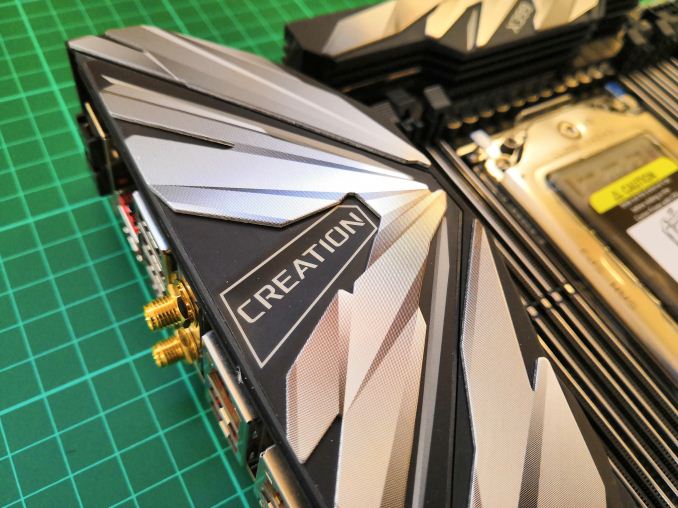
Reminder if you have forgotten the name. Creation

Connecting drives on the motherboard comes in two forms: eight SATA ports and seven slots for drives M.2. This is not a typo: MSI included seven M.2 slots for this motherboard. Three of them are on the board, and were found under the radiator of the chipset. Here are two of them:

The remaining four are on an additional PCIe card. We also saw it on Computex, and it uses a two-slot design. The board looks like a graphics processor:
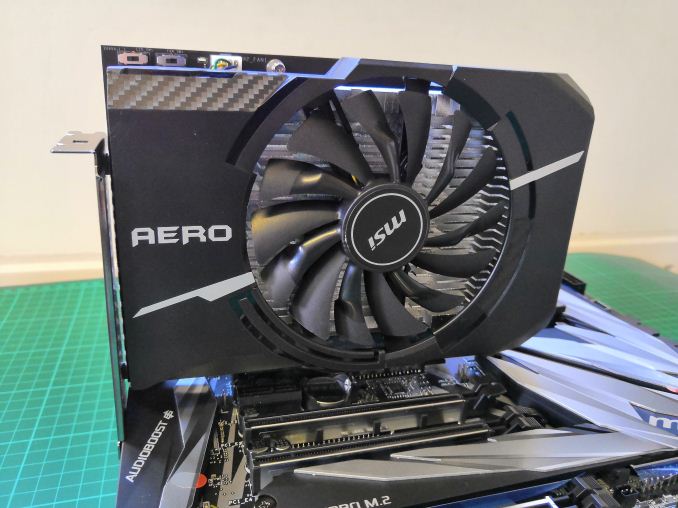
But inside there are four M.2 slots, with a thermocouple on the radiator to help cooling.
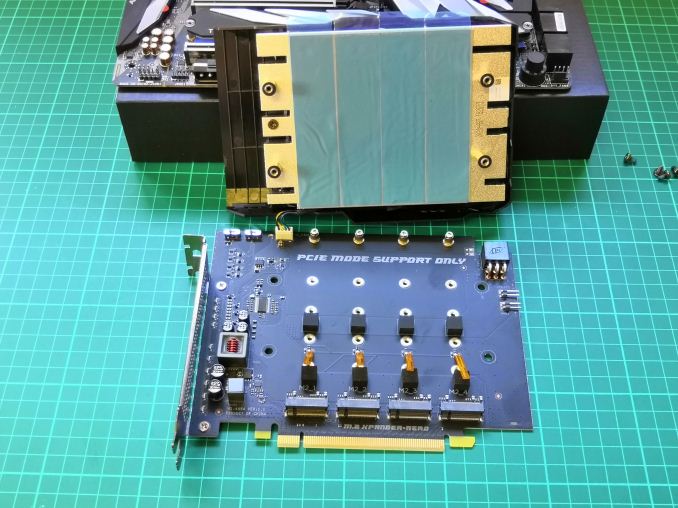
MSI states that it was designed specifically for the Threadripper, so I'm going to torture our SSD reviewer Billy Tallis to plug in a few more drives.

The board also has an extensive rear panel with USB 3.1 ports, USB 3.0 ports, Ethernet and Wi-Fi:

As already mentioned, AMD only demonstrated what the new product looks like, provided some technical specifications. AMD France published information about the speed of the 32-core Cinebench R15, giving it a rating of 5099:
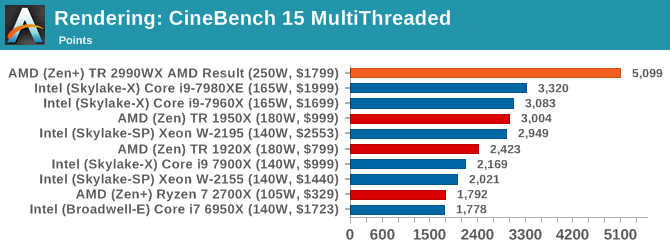
My review, focused on CPU tests, using our newest set of benchmarks, will be published later. I still perform a set of game tests for processors with new games and drivers. At the moment, in front of me a series of trips - 30,000 miles (FMS, Hot Chips, IFA, vacation). In addition, I need to conduct tests on Cannon Lake and a couple more devices, the reader will have to be patient. Augustus has never been so busy, honestly.

Thank you for staying with us. Do you like our articles? Want to see more interesting materials? Support us by placing an order or recommending to friends, 30% discount for Habr's users on a unique analogue of the entry-level servers that we invented for you: The whole truth about VPS (KVM) E5-2650 v4 (6 Cores) 10GB DDR4 240GB SSD 1Gbps from $ 20 or how to share the server? (Options are available with RAID1 and RAID10, up to 24 cores and up to 40GB DDR4).
3 months for free if you pay for new Dell R630 for a period of half a year - 2 x Intel Deca-Core Xeon E5-2630 v4 / 128GB DDR4 / 4x1TB HDD or 2x240GB SSD / 1Gbps 10 TB - from $ 99.33 a month , only until the end of August, order can be here .
Dell R730xd 2 times cheaper?Only we have 2 x Intel Dodeca-Core Xeon E5-2650v4 128GB DDR4 6x480GB SSD 1Gbps 100 TV from $ 249 in the Netherlands and the USA! Read about How to build an infrastructure building. class c using servers Dell R730xd E5-2650 v4 worth 9000 euros for a penny?

2990WX for pre-orders was opened on August 6, 2018. The start of retail sales began on August 13th.
Officially, the sale of new processors began on August 13, but in the largest markets, the first processors were available for pre-order already on August 6. AMD plans to launch four second-generation versions of the Ryzen Threadripper during the third quarter, starting with the flagship 32-core CPU.

At the top of the list of new processors is the 32-core 2990WX, with a recommended price of $ 1,800, which makes it a direct competitor to the already existing 18-core Intel Core i9-7980XE. AMD uses "WX" in the title to somehow show the consistency of branding with its high-quality Radeon Pro WX series graphics processors.
The heart of the most powerful ThreadRipper is the four Zen + Zeppelin 12 nm arrays, each with eight cores connected by Infinity Fabric from AMD, which provides simultaneous multithreading for all 64 threads. As in previous generations, there are 60 PCIe 3.0 lanes for drives or other devices, and four more lanes for the chipset. The speed of working with memory has been increased - the new processors support DDR4-2933.

The WX continues with the Ryzen Threadripper 2970WX line, which is noticeably cheaper: $ 1299 MSRP. This 24-core CPU uses three cores on the CCX (six cores per matrix, and the processor includes four such matrices), has simultaneous multithreading for all 48 threads. The core frequencies are the same as the TR 2990WX, the base 3.0 GHz and the single-core 4.2 GHz turbo. As shown below, the turbo speeds on the primary level will be determined by Precision Boost 2 and XFR2. The launch of 2970WX is scheduled for October.
Both WX models have a very high TDP of 250 W, although the way AMD measures TDP largely depends on the cooler used. The “benchmark” version is the new high-end Wraith Ripper cooler, which was developed by the Cooler Master. The cooler is very large, it offers full radiator coverage, which, as we found out, is crucial for cooling the Threadripper. The cooler will be sold separately, the fixed price is about $ 100 MSRP.

The next in the table are 2950X ($ 899) and 2920X ($ 649), which use the already existing X branding. Processors are direct replacements for the 1950X and 1920X. Each chip has only two active matrices, but plus it uses Zen + technology, Ryzen’s second-generation features, such as faster caches and better frequency response. The 16-core TR 2950X will have a base frequency of 3.5 GHz, a 4.4 GHz turbo and should go on sale on August 31. The 12-core TR 2920X, for comparison, comes with a base frequency of 3.5 GHz, but a 4.3 GHz turbo, and will be released in October. Both processors have 180 W of TDP, as well as chips of the first generation.

So far, AMD has not announced plans to expand the family, so we do not know whether 1900X will remain at the bottom of the stack, whether it will be replaced by a 2000 series model, or simply out of production.
At this stage, AMD is still opposing Intel’s Skylake-X components. The 32-core 2990 WX will align with the 18-core Core i9-7980XE.

As for the specifications, AMD has a large number of cores, is competitive in frequency, has more memory channels, more PCIe-bands and supports higher memory clock speeds. Intel, in turn, has lower power and a slight advantage in turbo frequencies. Meanwhile, we have already figured out from the Ryzen 2000 test series that there is a serious opposition in caching speed, and Intel has a slight advantage in IPC. The game has begun.
What's new: Zen +
The entire Ryzen Threadripper 2000 series has Zen cores in the “Zen +” mode, which adds three or four new features that are identical to the Ryzen 2000 series.
First, these are faster caches of all levels. As we saw in our review of the Ryzen 7 2700X, the L1 and L2 caches are slightly faster, the L3 cache was somewhat faster. Memory frequency support increased from DDR4-2666 to DDR4-2933. All this explains the increase in IPC by 3% and is the result of a better understanding of the design and adjustment of internal interactions for better performance.

Secondly, Zen + cores were created using the GlobalFoundries 12-nm process, an enhanced version of the 14-nm process that was previously used in the Threadripper-1000. Although optical shrinkage does not allow AMD to use higher frequencies or reduce voltage, along with a new turbo methodology and a 3% increase in IPC from caches, the overall performance increase in Ryzen 2000 series processors was 10%.

The third function is Precision Boost 2, which controls how the CPU implements its turbo depending on the workload. Instead of referring to a fixed turbo table, depending on how many cores are active and at what frequency, PB2 uses internal sensors and determines what energy / temperature is still available, and offers the CPU to increase the frequency until it reaches barrier. Due to the 25-MHz multiplier pitch, this allows the processor to maximize performance. We have seen the work of this function on the processors of the Ryzen 2000 series, the processors worked very well, although it is worth noting that this results in an increase in energy consumption for workloads with variable multithreading.

Fourth, this is XFR2, or “eXtended Frequency Range”. This is, in fact, the “temperature” bit of Precision Boost 2, taking advantage of the cooler ambient temperature and better cooling to increase the processor frequency. This provided an increase in performance by 10-15% for Ryzen 2000 series processors. In this announcement, not being able to conduct our own performance tests, we cannot provide you with accurate data. For this reason, both the Wraith Ripper (250 W air cooler) and Enermax Liqtech 240 (500 W liquid cooler) were included in our review.

(Note: we are currently experiencing a heat wave in Europe, one of the biggest in the world, and home air conditioning in the UK is out. As a result, AMD faces a potential failure, as many reviewers will be hampered by the super-high level of ambient air in their home space ( 32C +.) I was lucky - Intel invited me to an event in San Francisco this week, so, despite the fact that I had to drag 30 kg of equipment to a distance of 5500 miles, I am currently testing in a hotel room with a regulator at a temperature of 20 ° C. All this is said so that European reviewers will repeat the test after a few months when the ambient temperature returns to a pleasant coolness).
Remember the memory
One of the main questions, during the announcement of the second generation of Threadripper, concerned the configuration of the memory. In the first generation, two active crystals on the chip used two memory channels, for a total of four. The second generation with four active matrices now has an uneven memory design: two matrices have access to two memory channels each, while the other two matrices have zero memory channels that are directly connected. It turns out to access the memory requires a transition.

To clarify and avoid speculation, this is NOT a single-channel design per matrix. It is intended only to update the mid-level micro-architecture, and not to complete the update. One advantage is that these processors must fit into all motherboards that are currently on the market, without BIOS firmware. After installing the processor, a BIOS update is recommended for enhanced memory support and additional functions.
When discussing the issue with AMD, we were informed that this memory configuration works as follows: the scheduler in the operating system seeks to first fill in the kernels directly connected to the memory controller. Nevertheless, it is very difficult to initially load all 16 cores on two directly connected matrices: after the first several streams have been allocated, the new streams will enter the cyclic rotation mode, where the “value” of the stream and its core changes depending on how they are loaded. other kernels. If it makes sense in terms of power and temperature parameters, flows will appear on silicon that is not directly connected to memory, for example. Planning threads Threadripper 2 is much more difficult than it might seem at first glance.
Although users have talked many times about better memory allocation, almost no one has touched on the PCIe situation. As in the case of memory, PCIe lanes will also come from only two silicon arrays, and not split between all four. Therefore, most motherboards must support multiple graphics cards and other optional devices.
Stop talking, show the chip
In general, the new chips are very similar to the old ones:

AMD provided us with 2990WX and 2950X for our review on the release day. Both processors come out in August, first from 2990WX on August 13th, and then from 2950X (on the 31st).
On the reverse side, there is some difference in the arrangement of the components depending on the different active matrices:

2990WX (left) and 2950X (right) The
packaging has certainly become different - AMD seems to have taken into account public comments on the first-generation packaging. My only feedback for AMD is now this: make a new stackable processor package - because for a reviewer who has a lot of these chips there is no possibility to fold them properly, and this becomes an “organizational” nightmare.

In addition, the box contains a Torx screwdriver for a socket and an Asetek water cooler bracket, as well as for the first generation.

We decided to add EPYC properties to the mix and take a nice photo. Here are the 172 Zen cores:

AMD has included two motherboards in the press kit: the second revision of the ASUS X399 Zenith Extreme with the new VRM cooling kit, and MSI X399 MEG Creation, the 19-phase monster shown in Computex.

At first, they could not interest Summer:

But then she sniffed them:

And they became friends. (ed: Ian, if you kill this processor with static electricity, I will kill you.)

Installation note. Processors do it as they want.

But this is hardly a good idea.
X399 Motherboards: MSI X399 Creation
As for the motherboard, AMD explained that all motherboards on the market today will be able to work with the new 250 W processors. The differences in how well each motherboard can accelerate. AMD believes that new models and versions should work better, given that they were built with a higher power rating. Boards like the X399 Creation should help advance the first-generation Ryzen Threadripper.


This is a box. And inside the board.

As noted on the Computex, MSI X399 Creation is a very visually filled motherboard. Many corners and many shades of gray. I know that in some Asian languages and magazines it is customary to place everything as closely as possible, so I perceive it. As for me, I prefer a more simple, elegant design. This design is not too elegant.

The whole point of this motherboard is the power supply. MSI placed 16 phases in the processor, and three more - for the “uncore” part of the chip or, according to AMD, SoC. To accommodate them, the DRAM slots are slightly below average, although it also allowed MSI to install a larger heatsink, which is also connected to the heatsink on the rear panel of the board.

Reminder if you have forgotten the name. Creation

Connecting drives on the motherboard comes in two forms: eight SATA ports and seven slots for drives M.2. This is not a typo: MSI included seven M.2 slots for this motherboard. Three of them are on the board, and were found under the radiator of the chipset. Here are two of them:

The remaining four are on an additional PCIe card. We also saw it on Computex, and it uses a two-slot design. The board looks like a graphics processor:

But inside there are four M.2 slots, with a thermocouple on the radiator to help cooling.

MSI states that it was designed specifically for the Threadripper, so I'm going to torture our SSD reviewer Billy Tallis to plug in a few more drives.

The board also has an extensive rear panel with USB 3.1 ports, USB 3.0 ports, Ethernet and Wi-Fi:

Where are the benchmarks?
As already mentioned, AMD only demonstrated what the new product looks like, provided some technical specifications. AMD France published information about the speed of the 32-core Cinebench R15, giving it a rating of 5099:

My review, focused on CPU tests, using our newest set of benchmarks, will be published later. I still perform a set of game tests for processors with new games and drivers. At the moment, in front of me a series of trips - 30,000 miles (FMS, Hot Chips, IFA, vacation). In addition, I need to conduct tests on Cannon Lake and a couple more devices, the reader will have to be patient. Augustus has never been so busy, honestly.

Thank you for staying with us. Do you like our articles? Want to see more interesting materials? Support us by placing an order or recommending to friends, 30% discount for Habr's users on a unique analogue of the entry-level servers that we invented for you: The whole truth about VPS (KVM) E5-2650 v4 (6 Cores) 10GB DDR4 240GB SSD 1Gbps from $ 20 or how to share the server? (Options are available with RAID1 and RAID10, up to 24 cores and up to 40GB DDR4).
3 months for free if you pay for new Dell R630 for a period of half a year - 2 x Intel Deca-Core Xeon E5-2630 v4 / 128GB DDR4 / 4x1TB HDD or 2x240GB SSD / 1Gbps 10 TB - from $ 99.33 a month , only until the end of August, order can be here .
Dell R730xd 2 times cheaper?Only we have 2 x Intel Dodeca-Core Xeon E5-2650v4 128GB DDR4 6x480GB SSD 1Gbps 100 TV from $ 249 in the Netherlands and the USA! Read about How to build an infrastructure building. class c using servers Dell R730xd E5-2650 v4 worth 9000 euros for a penny?
